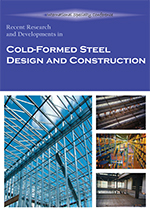Session Dates
24 Aug 2012 - 25 Aug 2012
Abstract
Trapezoidal sheeting, made of cold-formed, thin-walled steel, is widely used for the construction of cladding and roofs. At an interior support, the sheeting is subject to bending moments and a concentrated load, which leads to possible failure followed by two post-failure modes: the yield-arc and yield-eye modes. Until recently, it was not fully understood why a specific post-failure mode occurs and it was suggested that mode-jumping of the compressed sheeting flange may influence the mode occurring. This paper presents new research, in which both the compressed flange in isolation and the sheeting are modeled by using an explicit, dynamic finite element model. First, it is indicated that the mode-jumping phenomenon is not likely to occur for trapezoidal sheeting as used in practice. Secondly, it will be shown that whether the yield-arc or yield eye post-failure occurs is mainly related to imperfections and the ratio between stresses caused by bending moment and concentrated load. Lastly, a simple yet accurate formula will be derived, which predicts the post-failure mode occurring, thus enabling further investigations into the sheeting's behavior, like moment redistribution and behavior of second and third generation sheeting.
Department(s)
Civil, Architectural and Environmental Engineering
Research Center/Lab(s)
Wei-Wen Yu Center for Cold-Formed Steel Structures
Meeting Name
21st International Specialty Conference on Cold-Formed Steel Structures
Publisher
Missouri University of Science and Technology
Document Version
Final Version
Rights
© 2012 Missouri University of Science and Technology, All rights reserved.
Document Type
Article - Conference proceedings
File Type
text
Language
English
Recommended Citation
Hofmeyer, Hèrm, "An Explicit, Dynamic Finite Element Model for the Local Failure of Cold-formed Trapezoidal Sheeting" (2012). CCFSS Proceedings of International Specialty Conference on Cold-Formed Steel Structures (1971 - 2018). 4.
https://scholarsmine.mst.edu/isccss/21iccfss/21iccfss-session6/4
An Explicit, Dynamic Finite Element Model for the Local Failure of Cold-formed Trapezoidal Sheeting
Trapezoidal sheeting, made of cold-formed, thin-walled steel, is widely used for the construction of cladding and roofs. At an interior support, the sheeting is subject to bending moments and a concentrated load, which leads to possible failure followed by two post-failure modes: the yield-arc and yield-eye modes. Until recently, it was not fully understood why a specific post-failure mode occurs and it was suggested that mode-jumping of the compressed sheeting flange may influence the mode occurring. This paper presents new research, in which both the compressed flange in isolation and the sheeting are modeled by using an explicit, dynamic finite element model. First, it is indicated that the mode-jumping phenomenon is not likely to occur for trapezoidal sheeting as used in practice. Secondly, it will be shown that whether the yield-arc or yield eye post-failure occurs is mainly related to imperfections and the ratio between stresses caused by bending moment and concentrated load. Lastly, a simple yet accurate formula will be derived, which predicts the post-failure mode occurring, thus enabling further investigations into the sheeting's behavior, like moment redistribution and behavior of second and third generation sheeting.



